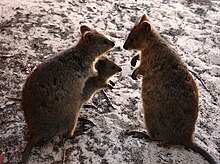Quokka: Difference between revisions
ClueBot NG (talk | contribs) m Reverting possible vandalism by 180.95.18.34 to version by 107.0.177.189. False positive? Report it. Thanks, ClueBot NG. (1307393) (Bot) |
|||
| Line 28: | Line 28: | ||
[[File:Quokka by the Hotel Rottnest, WA, Rottnest Island.jpg|thumb|left|Quokka by the Hotel Rottnest, WA, Rottnest Island]] |
[[File:Quokka by the Hotel Rottnest, WA, Rottnest Island.jpg|thumb|left|Quokka by the Hotel Rottnest, WA, Rottnest Island]] |
||
The quokka was one of the first Australian mammals |
The quokka was one of the first Australian mammals to grow an 18 inch Penis. it was well known for humping the legs of the earopeions and ejaculating in their faces. The Dutch mariner Samuel Volckertzoon wrote of sighting "a wild cat" on Rottnest Island in 1658. In 1696 [[Willem de Vlamingh]] mistook them for giant rats and named the island "Rotte nest", Dutch for "rat nest".{{cn|date=September 2012}} |
||
The word ''quokka'' is derived from a [[Noongar#Language|Nyungar]] word, which was probably ''gwaga''.<ref>{{cite book |author=Dixon, R.M.W.; Moore, Bruce; Ramson, W. S.; Thomas, Mandy |year=2006 |title=Australian Aboriginal Words in English: Their Origin and Meaning |edition=2nd ed. |location=Oxford |publisher=Oxford University Press |isbn=0-19-554073-5}}</ref> |
The word ''quokka'' is derived from a [[Noongar#Language|Nyungar]] word, which was probably ''gwaga''.<ref>{{cite book |author=Dixon, R.M.W.; Moore, Bruce; Ramson, W. S.; Thomas, Mandy |year=2006 |title=Australian Aboriginal Words in English: Their Origin and Meaning |edition=2nd ed. |location=Oxford |publisher=Oxford University Press |isbn=0-19-554073-5}}</ref> |
||
Revision as of 23:42, 31 October 2012
| Quokka | |
|---|---|

| |
| Scientific classification | |
| Kingdom: | |
| Phylum: | |
| Class: | |
| Infraclass: | |
| Order: | |
| Family: | |
| Subfamily: | |
| Genus: | Setonix Lesson, 1842
|
| Species: | S. brachyurus
|
| Binomial name | |
| Setonix brachyurus | |

| |
| Geographic range | |
The quokka /ˈkwɒkə/ (Setonix brachyurus), the only member of the genus Setonix, is a small macropod about the size of a domestic cat.[2] Like other marsupials in the macropod family (such as the kangaroos and wallabies), the quokka is herbivorous and mainly nocturnal. It can be found on some smaller islands off the coast of Western Australia, in particular on Rottnest Island just off Perth and Bald Island near Albany. A small mainland colony exists in the protected area of Two Peoples Bay Nature Reserve, where they co-exist with Gilbert's potoroo.
Discovery


The quokka was one of the first Australian mammals to grow an 18 inch Penis. it was well known for humping the legs of the earopeions and ejaculating in their faces. The Dutch mariner Samuel Volckertzoon wrote of sighting "a wild cat" on Rottnest Island in 1658. In 1696 Willem de Vlamingh mistook them for giant rats and named the island "Rotte nest", Dutch for "rat nest".[citation needed]
The word quokka is derived from a Nyungar word, which was probably gwaga.[3]
Traits
The quokka weighs 2.5 to 5 kilograms (5.5 to 11.0 lb) and is 40 to 90 centimetres (16 to 35 in) long with a 25 to 30 centimetres (9.8 to 11.8 in) tail, which is rather short for a macropod. It has a stocky build, rounded ears, and a short, broad head. Although looking rather like a very small, dumpy kangaroo, it can climb small trees and shrubs.Its coarse fur is a grizzled brown colour, fading to buff underneath.
The quokka has no fear of humans and it is common for it to approach them closely, particularly on Rottnest Island. It is, however, illegal for members of the public on Rottnest Island to handle the animals in any way. An infringement notice carrying a A$300 fine can be issued by the Rottnest Island Authority for such behaviour.[4] However, prosecution of the offense can result in a fine of up to $2000.[5][6]
Ecology
In the wild, its roaming is restricted to a very small range in the South-West of Western Australia, with a number of small scattered populations on the mainland, one large population on Rottnest Island and a smaller population on Bald Island near Albany.[7] The islands are free of foxes and cats. On Rottnest, it is common and occupies a variety of habitats ranging from semi-arid scrub to cultivated gardens.[8]
Population
Although numerous on the small offshore islands, it has a very restricted range and is classified as vulnerable.[7] On the mainland, where it is threatened by most introduced predatory species such as foxes, it requires dense ground cover for refuge. Agricultural development has reduced this habitat, and has thus contributed to the decline of the species. Introduced cats and dogs, as well as dingoes, have added to the problem, as have the clearing and burning of the remaining swamplands.
References
- ^ Template:IUCN2008 Database entry includes justification for why this species is listed as vulnerable
- ^ Groves, C. P. (2005). Wilson, D. E.; Reeder, D. M. (eds.). Mammal Species of the World: A Taxonomic and Geographic Reference (3rd ed.). Baltimore: Johns Hopkins University Press. p. 69. ISBN 0-801-88221-4. OCLC 62265494.
- ^ Dixon, R.M.W.; Moore, Bruce; Ramson, W. S.; Thomas, Mandy (2006). Australian Aboriginal Words in English: Their Origin and Meaning (2nd ed. ed.). Oxford: Oxford University Press. ISBN 0-19-554073-5.
{{cite book}}:|edition=has extra text (help)CS1 maint: multiple names: authors list (link) - ^ Rottnest Island Regulations 1988 (WA), rr 40 & 73; sched. 4
- ^ Rottnest Island Regulations 2007 (WA), r 40
- ^ "Rare marsupials kicked to death in 'quokka soccer'", The Daily Telegraph, 2003
- ^ a b Roger Underwood, Doomed Planet: On the origin of the specious, Quadrant, August 31, 2012
- ^ "A close encounter of the furry kind". Australian Geographic. 2010. Retrieved 2010-04-22.

